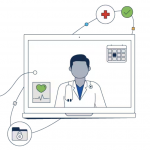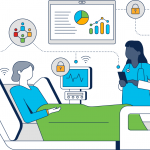Research from IDC Health Insights (Clinical Buyer Behavior Study) shows on average clinicians typically use 6.4 different mobile devices daily for professional use. Recently, I participated in a Cisco Bring Your Own Device (BYOD) workshop discussing challenges Healthcare organizations have supporting mobile devices with reliable, high performance, in-building wireless coverage while maintaining operational efficiencies. Healthcare experts from Networking, Security and IT discussed challenges facing Healthcare and various ways BYOD is defined. A common question is how to address challenges with BYOD. What recommendations does Cisco Healthcare offer in implementing BYOD? What options are available with wireless reducing security risks? What are Cisco’s best practices with BYOD maintaining compliance with regulatory policies and accreditation requirements?
Healthcare organizations struggle with common issues: improving the patient experience, attracting the best talent, cultivating greater workforce productivity and discovering new ways of increasing efficiency in delivering care. While technology increases flexibility, agility and maintains productivity, devices speed physician rounds allowing them to see more patients, spend more time with patients. While BYOD in healthcare is largely driven by the physician constituents, .. in reality, demand for BYOD comes from all roles across the organization: Chief Medical Officers, CIOs, Hospital Administration, Operations, Clinicians and IT. There is increasing demand from all users for increased access and flexibility. Additionally, there are high expectations for a mobile workspace to attract new physicians and retain the best talent. Everyone accepts that multiple devices allow for greater increase in productivity but at the same time acknowledge it’s a balancing act maintaining security, compliance and HIPAA requirements.
What if you could solve all these challenges at the same time?
What if you could improve coordination of care by opening the network to your clinicians and staff while lowering IT cost and complexity?
What if you could let staff have greater mobile access and flexibility… while protecting patient data and intellectual property?
What if your organization could work with the device of their choice… without compromising your organization or the quality of care delivered?
Consider what several Healthcare customers are doing to begin addressing their challenges. Engage Cisco Advanced Services in a custom Unified Workspace/BYOD Architecture Strategy workshop. The onsite workshop involves participants from all roles of your organization including IT, Security, Applications, and Clinicians. Since BYOD becomes an organization challenge impacting compliance, security policies and workflow processes it’s important to have cross functional participation in the workshop. The custom Unified Workspace/BYOD Architecture Strategy workshop delivers everything you’ll need for a comprehensive architecture plan.
Consider the workshop to begin addressing your needs based on a technology framework for improved collaboration and productivity. To learn more about the Unified Workspace/BYOD Architecture Strategy Workshop or contact: uw-sales@external.cisco.com



hi,
i read about this article . the article didnot mention about wat are the wireless devices are used for this experiment.unified workspace strategy means wat it should be.
In the global healthcare scenario when a patient comes to hospital he is registered his name, age, sex, occupation, and his personel details.then he is reffered to doctor for an appointment .there doctor will ask about his health and takes his case history and he will give provisonal diagnosis.the next step is investigation (laboratory, medical imaging, some of clinical investigation).the next step doctors will read the ivestigation report gives final diagnosis.next step is treatment aspect. next step is follow up. all the above steps can be digitaliszed and kept in single server.all this steps should be unified into one platform where any healthcare proffessional can enter and see the whole case sheet . where it can be accessed from around the globe with all the internet accessible devices pc,laptop and tablet pc. all this can be done by GLOBAL HOSPITAL,DOCTORS NETWORK AND EMR WITH TELEMETRY OF MEDICAL DEVICES. it should be free of cost where entire health care system needs to adopt this archtecture and maintained for a while . then whole system can be improved slowly by new research and architecture should be open source so that every one can be iprowed to reach maximum limit.it can be implemented it with google.
thank you
telemedicine should consists of all these followings
1. Electronic medical records
2. Telemetry of medical devices ( multi parameter monitor, ultrasound scanning machine,ct, mri,)
3. Lab investigation report entering and order format.
4. tele pathology,microbiology physiology.
5. online prescription and treatment.
6.multi speciatlity case history book.
7.voice to type medical trancrition software.
8. written case history saving.
all these should be accessible through portabale internet devices and laptop and pc
thank you
Sorry for the delay in responding – due to the holidays.
Thank you Anil for your comments!